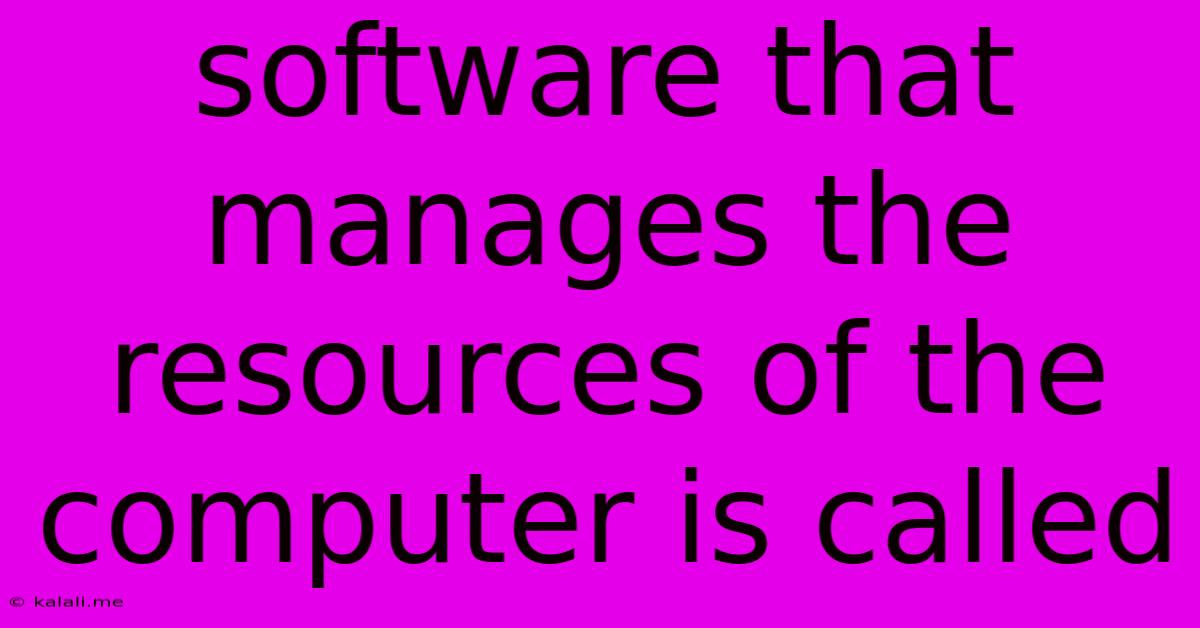Software That Manages The Resources Of The Computer Is Called
Kalali
Jun 14, 2025 · 3 min read

Table of Contents
Software That Manages Computer Resources: An In-Depth Look at Operating Systems
What's the unsung hero behind every click, every program launch, and every file saved on your computer? It's the operating system (OS), the crucial software that manages all of your computer's resources. This article delves into the vital role of operating systems, explaining their core functions and why they're essential for a smooth and efficient computing experience.
Operating systems are the fundamental software that acts as an intermediary between you, the user, and the computer's hardware. They handle everything from memory management and process scheduling to file systems and peripheral control. Without an OS, your computer would be nothing more than a collection of inert components.
Core Functions of an Operating System
An operating system performs many critical tasks, including:
- Memory Management: The OS allocates and manages computer memory, ensuring that different programs have the resources they need without conflicting with each other. This involves techniques like virtual memory, which extends the available RAM by utilizing hard drive space.
- Process Management: This involves controlling the execution of programs, allocating CPU time efficiently, and managing the flow of data between processes. The OS ensures that multiple programs can run concurrently without interfering with one another.
- File System Management: The OS organizes files and folders on storage devices (hard drives, SSDs, etc.), allowing users to easily access, save, and manage their data. Different file systems (like NTFS, FAT32, ext4) have different characteristics and capabilities.
- Peripheral Management: This includes managing input and output devices such as keyboards, mice, printers, and scanners. The OS ensures that these devices communicate effectively with the computer.
- Security: Modern operating systems incorporate security features to protect the system from malicious software (malware), unauthorized access, and data breaches. These features include firewalls, user authentication, and access control mechanisms.
- User Interface: The OS provides a user interface (UI) – either a command-line interface (CLI) or a graphical user interface (GUI) – that allows users to interact with the computer. GUIs are more common today, providing a visual, intuitive way to manage files, launch programs, and control system settings.
Types of Operating Systems
Operating systems come in various forms, each designed for specific purposes:
- Desktop Operating Systems: These are designed for personal computers and provide a user-friendly interface for general-purpose computing tasks. Popular examples include Windows, macOS, and various Linux distributions.
- Mobile Operating Systems: These are optimized for smartphones and tablets, featuring touch-screen interfaces and mobile-specific applications. Android and iOS are the dominant players in this market.
- Server Operating Systems: These are designed for powerful servers that manage networks and provide services to multiple users. They are typically optimized for stability, security, and performance. Examples include Windows Server and various Linux distributions.
- Embedded Operating Systems: These are specialized operating systems designed for embedded systems, such as those found in appliances, vehicles, and industrial machinery. They often have limited resources and are optimized for specific tasks.
Choosing the Right Operating System
The best operating system for you depends on your needs and preferences. Consider factors like:
- Hardware compatibility: Ensure the OS is compatible with your computer's hardware.
- Software compatibility: Check if the OS supports the software you need to run.
- User interface: Choose an OS with a user interface that you find intuitive and easy to use.
- Security: Select an OS with robust security features to protect your data and system.
- Cost: Some operating systems are free and open-source, while others are commercial products.
In conclusion, the software that manages a computer's resources is the operating system. It's the backbone of any computing experience, providing the essential functions necessary for running applications, managing files, and interacting with hardware. Understanding the role and functions of an OS is crucial for anyone who uses a computer.
Latest Posts
Latest Posts
-
Difference Between Mixture And Solution Examples
Jun 15, 2025
-
What Is The Antonym Of Inferior
Jun 15, 2025
-
When An Electron Is Removed The Atom Gets A
Jun 15, 2025
-
Moment Of Inertia Of A Thin Ring
Jun 15, 2025
-
How Are Plants Different From Algae
Jun 15, 2025
Related Post
Thank you for visiting our website which covers about Software That Manages The Resources Of The Computer Is Called . We hope the information provided has been useful to you. Feel free to contact us if you have any questions or need further assistance. See you next time and don't miss to bookmark.